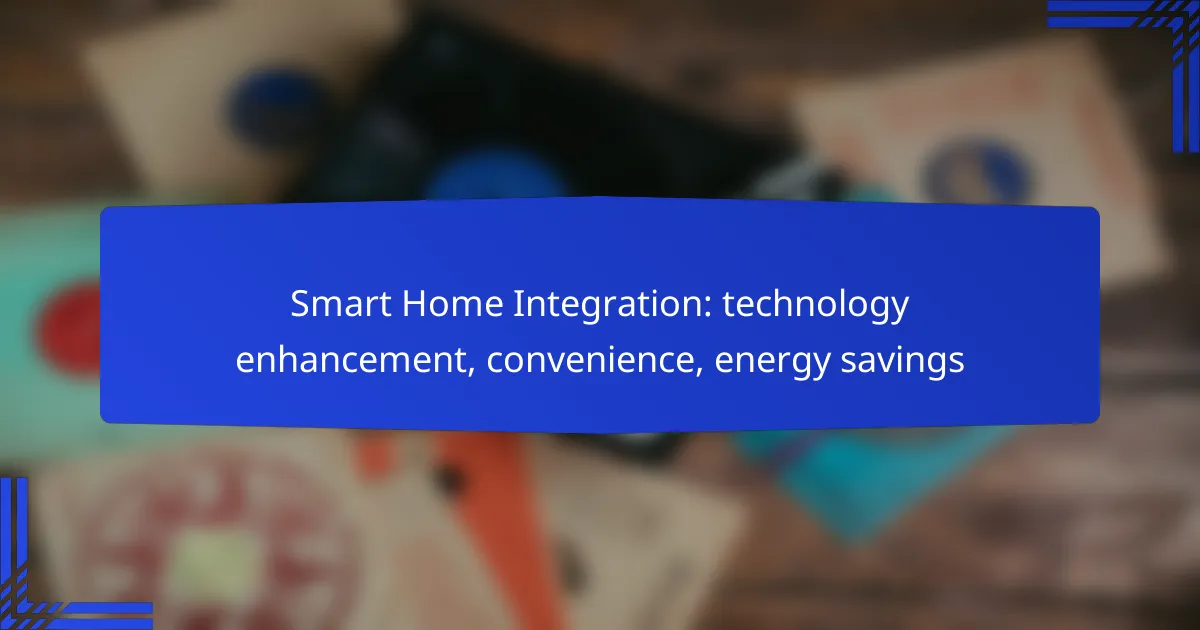Smart home integration revolutionizes modern living by connecting various devices to create a seamless and efficient environment. This technology not only enhances convenience through automation and remote access but also promotes energy savings by optimizing household device usage, ultimately leading to lower utility bills.

How does smart home integration enhance technology in the UK?
Smart home integration enhances technology in the UK by connecting various devices to create a cohesive and efficient living environment. This technology allows homeowners to manage their appliances, security systems, and energy usage seamlessly, leading to increased convenience and energy savings.
Improved connectivity with IoT devices
Smart home integration significantly improves connectivity with Internet of Things (IoT) devices, enabling them to communicate and work together. For instance, smart thermostats can adjust temperatures based on data from smart sensors that detect occupancy, optimizing energy use.
When selecting IoT devices, ensure they are compatible with your existing smart home ecosystem. Look for devices that support common communication protocols like Zigbee or Z-Wave, which enhance interoperability and expand your smart home capabilities.
Seamless control through mobile apps
Mobile apps provide seamless control over smart home devices, allowing users to manage their home environment from anywhere. Many apps offer centralized dashboards that display the status of connected devices, making it easy to monitor and adjust settings remotely.
To maximize convenience, choose apps that offer customizable notifications and automation features. For example, you can set up alerts for unusual activity or schedule lights to turn on and off at specific times, enhancing both security and energy efficiency.
Integration with voice assistants like Amazon Alexa
Integrating smart home devices with voice assistants like Amazon Alexa allows for hands-free control and enhanced user experience. Users can issue voice commands to adjust lighting, control thermostats, or even lock doors, making daily tasks more convenient.
When setting up voice assistants, ensure that your smart devices are compatible and properly configured. Regularly update the firmware of both the devices and the voice assistant to maintain security and functionality. Consider creating routines that automate multiple actions with a single command, further streamlining your smart home experience.

What are the convenience benefits of smart home integration?
Smart home integration offers significant convenience benefits by automating daily tasks, providing remote access to home systems, and enhancing security features. These technologies streamline household management, making life easier and more efficient.
Automated routines for daily tasks
Automated routines can simplify everyday activities, allowing devices to perform tasks at scheduled times or in response to specific triggers. For example, smart lights can turn on automatically at sunset, while smart thermostats adjust the temperature based on your daily schedule.
Consider setting up routines for morning and evening activities. You might program your coffee maker to start brewing when your alarm goes off, or have your smart speakers play your favorite music as you wake up. This can save time and create a more pleasant start to your day.
Remote access to home systems
Remote access allows homeowners to control various systems from anywhere using a smartphone or tablet. This means you can adjust your thermostat, turn off lights, or check security cameras while away from home, providing peace of mind and energy savings.
Many smart home devices come with user-friendly apps that enable real-time monitoring and control. For instance, if you forget to lock the front door, you can do so remotely, ensuring your home remains secure even when you are not there.
Enhanced security features
Smart home integration enhances security through features like smart locks, surveillance cameras, and motion sensors. These devices can alert you to unusual activity and allow you to monitor your property in real-time, increasing your overall safety.
For example, smart doorbells with video capabilities let you see and communicate with visitors from your smartphone, even when you are not home. Additionally, integrating motion sensors with lighting can deter intruders by automatically illuminating areas when movement is detected.
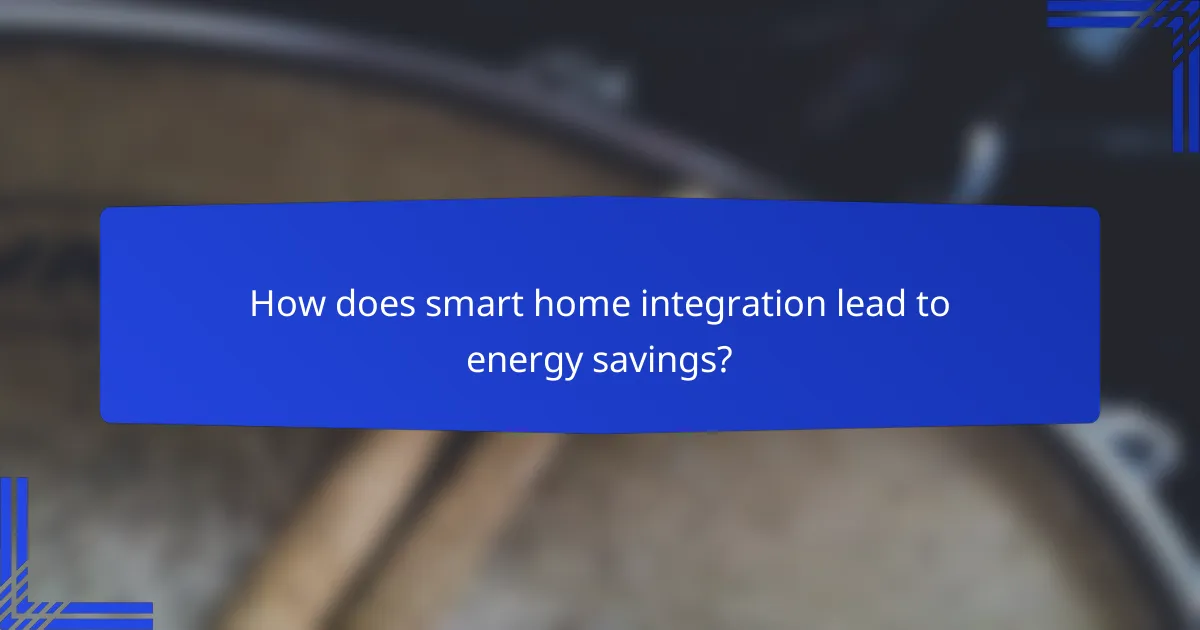
How does smart home integration lead to energy savings?
Smart home integration promotes energy savings by automating and optimizing the use of household devices. Through advanced technology, systems like smart thermostats and energy monitoring tools help reduce unnecessary energy consumption, leading to lower utility bills.
Smart thermostats for efficient heating
Smart thermostats adjust heating and cooling based on your schedule and preferences, ensuring that energy is not wasted when you’re not home. These devices can learn your habits over time, automatically adjusting temperatures to maximize comfort while minimizing energy use.
For example, a smart thermostat can lower the temperature when you leave for work and raise it just before you return, potentially saving up to 10-15% on heating costs. Look for models that offer remote access via smartphone apps for added convenience.
Energy monitoring systems
Energy monitoring systems provide real-time data on your energy consumption, helping you identify which devices use the most power. By understanding your usage patterns, you can make informed decisions to reduce energy waste.
Many systems allow you to set alerts for unusual energy spikes, which can indicate malfunctioning appliances. Consider investing in a system that integrates with your smart home platform for seamless monitoring and control.
Automated lighting controls
Automated lighting controls enable you to schedule lights to turn on or off based on occupancy or time of day, significantly reducing energy waste. Motion sensors can detect when a room is unoccupied and automatically switch off the lights.
Using smart bulbs that can be dimmed or scheduled can lead to energy savings of around 20-30%. Ensure compatibility with your existing fixtures and consider using timers or smart plugs for added flexibility in managing your lighting.
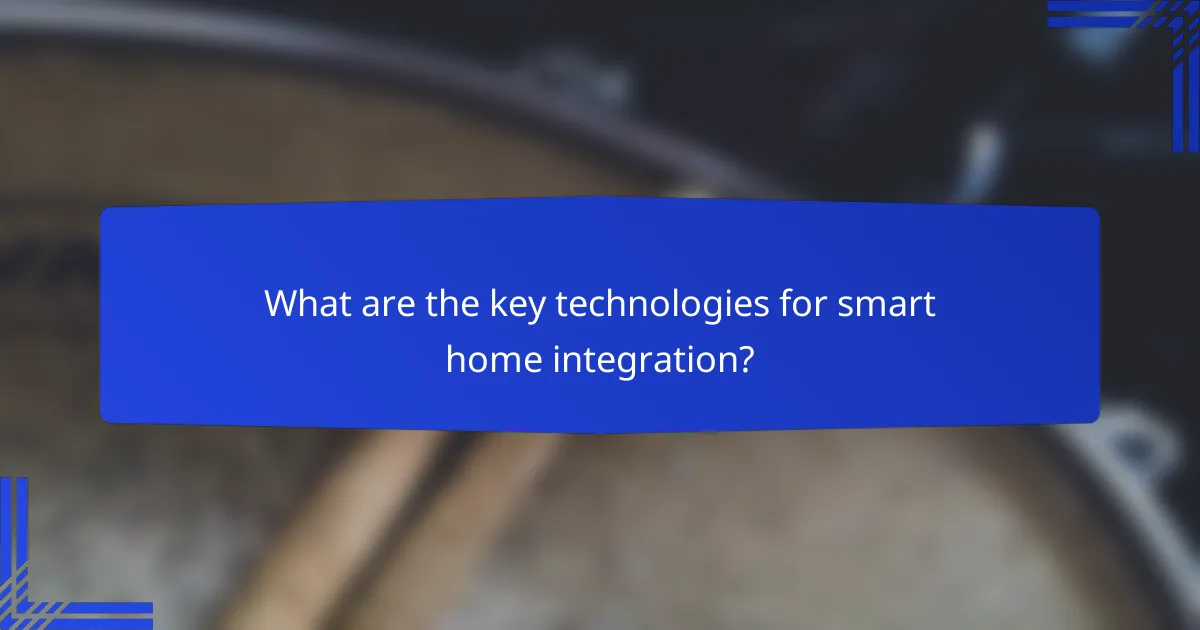
What are the key technologies for smart home integration?
The key technologies for smart home integration include various communication protocols, smart hubs, and home automation platforms. These technologies work together to enhance convenience, improve energy efficiency, and enable seamless control of smart devices.
Wi-Fi and Zigbee protocols
Wi-Fi and Zigbee are two primary communication protocols used in smart home integration. Wi-Fi provides high-speed internet connectivity for devices that require significant bandwidth, such as cameras and streaming devices, while Zigbee is designed for low-power, low-data-rate applications, making it ideal for sensors and smart bulbs.
When choosing between these protocols, consider the range and power consumption. Zigbee typically has a longer battery life for devices but operates over shorter distances compared to Wi-Fi. A combination of both can optimize performance across different types of devices in your smart home.
Smart hubs like Samsung SmartThings
Smart hubs, such as Samsung SmartThings, serve as central controllers for various smart devices, allowing them to communicate with each other. These hubs can connect devices using different protocols, enabling a unified control system through a single app.
When selecting a smart hub, ensure it supports the devices you plan to use and check for compatibility with popular ecosystems like Google Assistant or Amazon Alexa. This compatibility can significantly enhance your smart home experience by allowing voice control and automation routines.
Home automation platforms
Home automation platforms provide software solutions that allow users to create customized automation scenarios for their smart devices. These platforms can range from simple apps to comprehensive systems that manage multiple devices and settings based on user preferences.
Popular platforms include Google Home, Amazon Alexa, and Apple HomeKit. When choosing a platform, consider ease of use, available features, and integration capabilities with your existing devices. A well-chosen platform can streamline operations and maximize the benefits of your smart home setup.
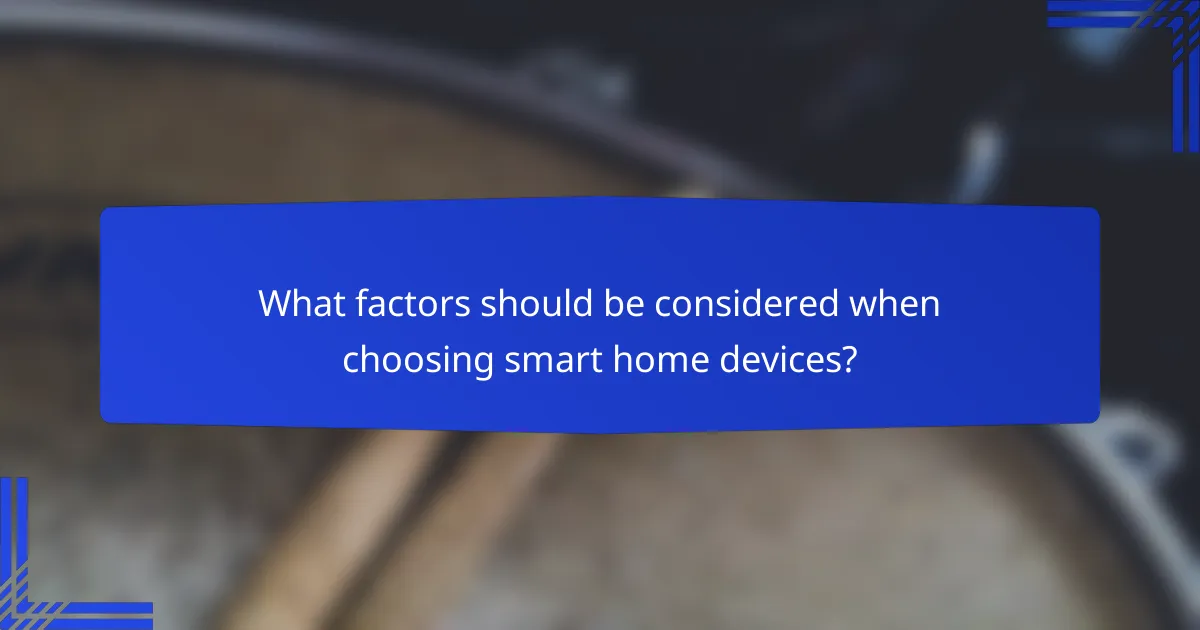
What factors should be considered when choosing smart home devices?
When selecting smart home devices, consider compatibility with your existing systems, scalability for future upgrades, and the brand’s reputation and support. These factors ensure that your smart home setup is efficient, adaptable, and backed by reliable customer service.
Compatibility with existing systems
Compatibility is crucial when integrating smart home devices. Ensure that the new devices can communicate with your current systems, such as smart hubs, Wi-Fi networks, and other connected appliances. For example, devices that support common protocols like Zigbee or Z-Wave can often work seamlessly together.
Before purchasing, check the specifications and user reviews to confirm that the devices will function well within your existing ecosystem. Avoid brands that require proprietary systems unless you are prepared to invest in a complete overhaul of your setup.
Scalability for future upgrades
Scalability refers to the ability to expand your smart home system over time. Choose devices that can easily integrate with additional products or services, allowing you to enhance your home automation without starting from scratch. For instance, selecting a smart hub that supports a wide range of devices can facilitate future upgrades.
Consider your long-term goals and whether the devices you choose can accommodate new technologies or features. Investing in scalable solutions can save you money and hassle in the future.
Brand reputation and support
Brand reputation plays a significant role in the reliability and longevity of smart home devices. Research brands known for quality products and excellent customer support. Look for companies that provide regular software updates and have a responsive customer service team.
Reading user reviews and ratings can offer insights into the experiences of other customers. Avoid brands with a history of poor support or frequent product failures to ensure a smoother smart home experience.
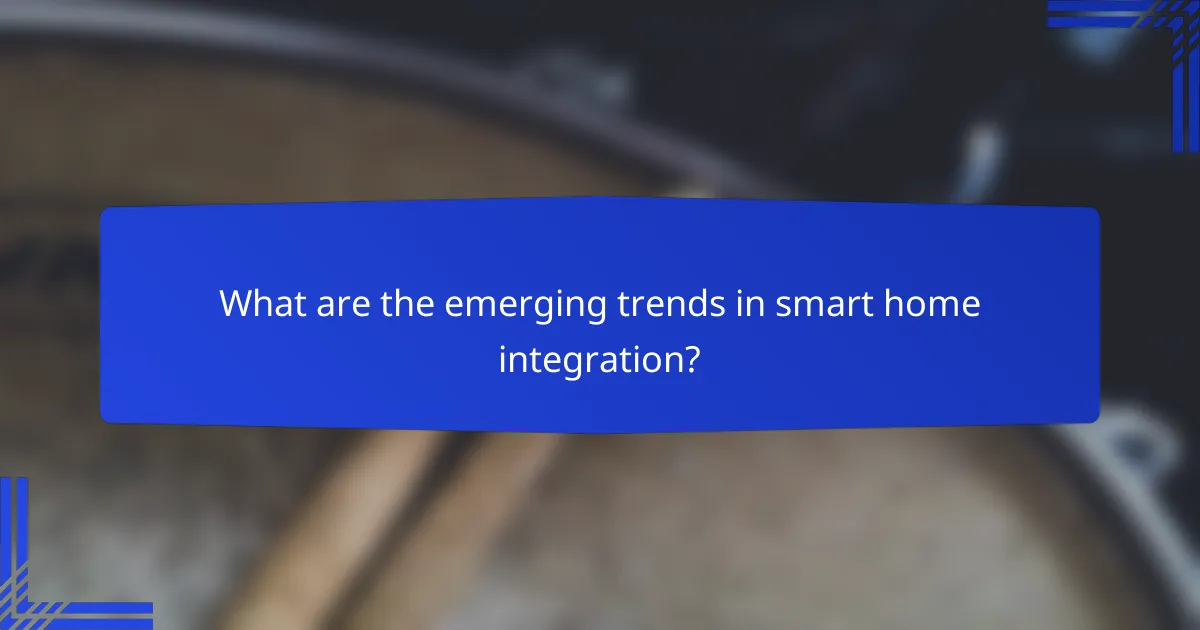
What are the emerging trends in smart home integration?
Emerging trends in smart home integration focus on enhanced technology, increased convenience, and energy savings. These trends include the rise of interconnected devices, advanced automation systems, and the use of artificial intelligence to optimize home management.
Interconnected Devices
Interconnected devices form the backbone of smart home integration, allowing various gadgets to communicate and work together seamlessly. This includes smart speakers, thermostats, lights, and security systems that can be controlled through a single app or voice command.
Consider investing in devices that support popular communication standards like Zigbee or Z-Wave, which enhance compatibility among different brands. For example, a smart thermostat can adjust the temperature based on data from smart sensors that detect occupancy, leading to improved energy efficiency.
Advanced Automation Systems
Advanced automation systems enable users to create customized routines that enhance convenience and efficiency. These systems can automate tasks such as adjusting lighting based on the time of day or locking doors at night.
Utilizing platforms like Google Home or Amazon Alexa allows for easy setup of these routines. For instance, you can program your home to turn off all lights and lower the thermostat when you leave for work, saving energy and reducing utility costs.
Artificial Intelligence for Optimization
Artificial intelligence (AI) plays a crucial role in optimizing smart home systems by learning user preferences and behaviors. AI can analyze data to make real-time adjustments, improving comfort and energy savings.
For example, AI-driven thermostats can learn your schedule and adjust heating or cooling accordingly, potentially reducing energy bills by a significant percentage. When selecting AI-enabled devices, look for those that offer machine learning capabilities for the best results.
